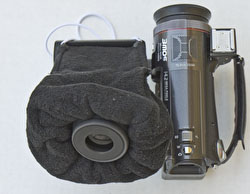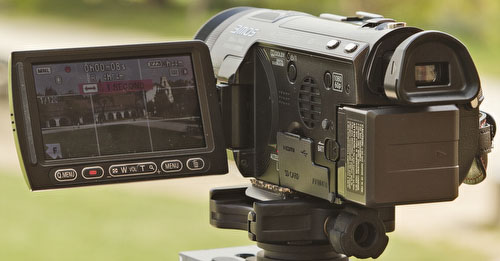7/18/2010 TM700 with Sock-Loupe

5/29/2010 Hollister Vintage Car Ralley
Filmed with Panasonic TM700 at 1080p60
- in parts used the Sock-Loupe
Transcoded to 720p30 ProRes LT
Edited in FCP
Output rendered to Apple TV
Video at Vimeo.
5/29/2010 Hollister Airshow: Aerobatics
Filmed with Panasonic TM700 at 1080p60
- in parts used the Sock-Loupe
Transcoded to 720p30 ProRes LT
Edited in FCP
Output rendered to Apple TV
Video at Vimeo.
5/17/2010 Video: SJB Car Fun
Most clips are as shot (except some software IS with FCP Smoothcam).
Here is the movie "SJB Car Fun" at Vimeo.
5/16/2010 Initial Findings
In the past we did not get much excited about smaller consumer camcorders and we hoped the HDSLRs (Canon 5D2, 7D, 550D or Panasonic GH1) would do all we need.
One thing for sure the HDSLRs can produce great movies in the right hands. Unfortunately using these HDSLRs is not always fun. Here is why:
- Problem #2: Rolling Shutter: This is mainly a problem when you move the camera. But it also makes it harder to use software image stabilization during editing.
- Problem #3: Viewfinders. While the Panasonic GH1 has an EVF and LCD you can only use the LCD for video on the Canon HDSLRs. At normal daytime the LCDs are close to useless unless you use an additional viewfinder or a LCD hood. HDSLR movie makers often use external monitors to solve this issue. Of course this adds bulk (not to mention the cost).
- Problem #4: It is very hard to use the HDSLRs handheld because the lens image stabilization is not good enough to get good movie static shots (the Canon IS is also noisy).
- Problem #5: Size and weight. The HDSLRs are light and reasonable small but if you add the needed accessories it adds up.
- Problem #6: The Panasonic GH1 is clearly the most advanced in terms of video among all the new HDSLRs. Except that the GH1 bit-rate is quite low and this means that fine details suffer.
- Problem #7: The HDSLRs either do not support AF during filming or get too easily fooled
Of course these HDSLRs would not be such a hot topic without major strong points:
- Large sensors produce shallow DOF which adds to a filmic look
- Large sensors allow amazing low light quality (ISO 1600 is no big problem)
The Michael Reichmann published a review about the Panasonic TM700 which got us thinking.
What are our personal requirements right now for making videos?
- We mainly want to film short documentaries about scenes and places we photograph
- We often film at normal daytime (lots of sun here in CA)
- The camera should be small and fast to setup
- We likely don't film in low light scenes that much. If we need to we can use our Canon 550D or 5D2 anytime.
- We rather like more DOF for filming landscapes and urban scenes.
The Panasonic HDC-TM700 Camcorder

TM700
Unique Features (at least for an under $1,000 camcorder)
- 3 CMOS chips (means no debayering artifacts)
- Full HD 1080p at 60p. This is a mode that delivers also the highest bit rate and clearly best quality.
- Features both LCD and viewfinder
Here are some very early findings:
Pros
- Hardly any moire at 1080p 60p (watch video below, look at the roof)
Moire and IS Tests with TM700 at Vimeo
- Great detail
- Allows full manual control
- Has a viewfinder if needed. This is not a good viewfinder but at sunlight it beats a LCD any day.
- Very small
- Fast setup time makes it more likely we use it more often. Remember we switch between still camera and camcorder all the time.
- Image Stabilization is very good and allows shooting handheld.
- 60P allows to create smooth slow motion conversions
- Good zoom range 35-420mm (35mm equivalent) optical zoom. Some may want to get a WA adapter. We can use in these cases our 5D2 with a Zeiss 21mm lens.
- Helper tools like Zebras for highlight control and Peeking for Focus
- Motorized zoon works fairly smooth
- Records to 32GB internal flash memory (or SDHC cards). 32GB allows to record nearly 3 hours of video at the highest quality. For our work this is a lot because we assume to be with a computer in the evening (home workstation or MacBook Pro on trips). Not recording to a SD card has the advantage that we don't need to worry whether the SD card holds up. For us the SD card is more for backup. We transfer to our computer directly from the camera using the USB cable (plan to feature this in more detail later).
- Built in time lapse mode (watch video below)
Time Lapse with TM700 at Vimeo
Needs attention
- Handling of 1080p 60p footage needs some good workflow. The Mac cannot show the the MTS files in Quicktime. Roxio Toast 10 Titanium can play the 1080p 60p MTS files directly without any stutter.
Here is our main workflow in a nutshell (we plan an article on transcoding in the future):
- Wrap the MTS file to a .MOV with ClipWrap (this is a lossless step). The resulting .MOV is still 60p and plays on our Macs very stuttery (just a limit of Quicktime on out Macs). Note: ClipWrap may not support the TM700 officially but it works for us just great (try the demo version first).
- Transcode to 1080p (or sometimes 720p depending on my project) 30p ProRes LT in MPEG Streamclip. Now the clips can be easily edited in Final Cut Pro and viewed in Quicktime.
- Manual control works great but we have to get used to it.
Not so great
- Viewfinder (but as mentioned much better than none)
- Tilted viewfinder would be better
- Slight noise from the fan (no big deal though for our work)
- Need to close or flip 180 degrees the LCD to use the viewfinder. There should be an option for this.
- We would like the battery to be charged when using the power supply with the camera.
- High capacity battery is very expensive.
Our Accessories
- Extra normal battery (we can now film about 90 minutes on one load, conservative calculations)
- 4x and 8x ND filters at 46mm
- External Microphone
- Camhandle (works very well with cameras like the TM700)
Looks like we are at a good start. Leave all your questions as comments with our sample videos. Over the next weeks we start making some small movies and will feature them here. |